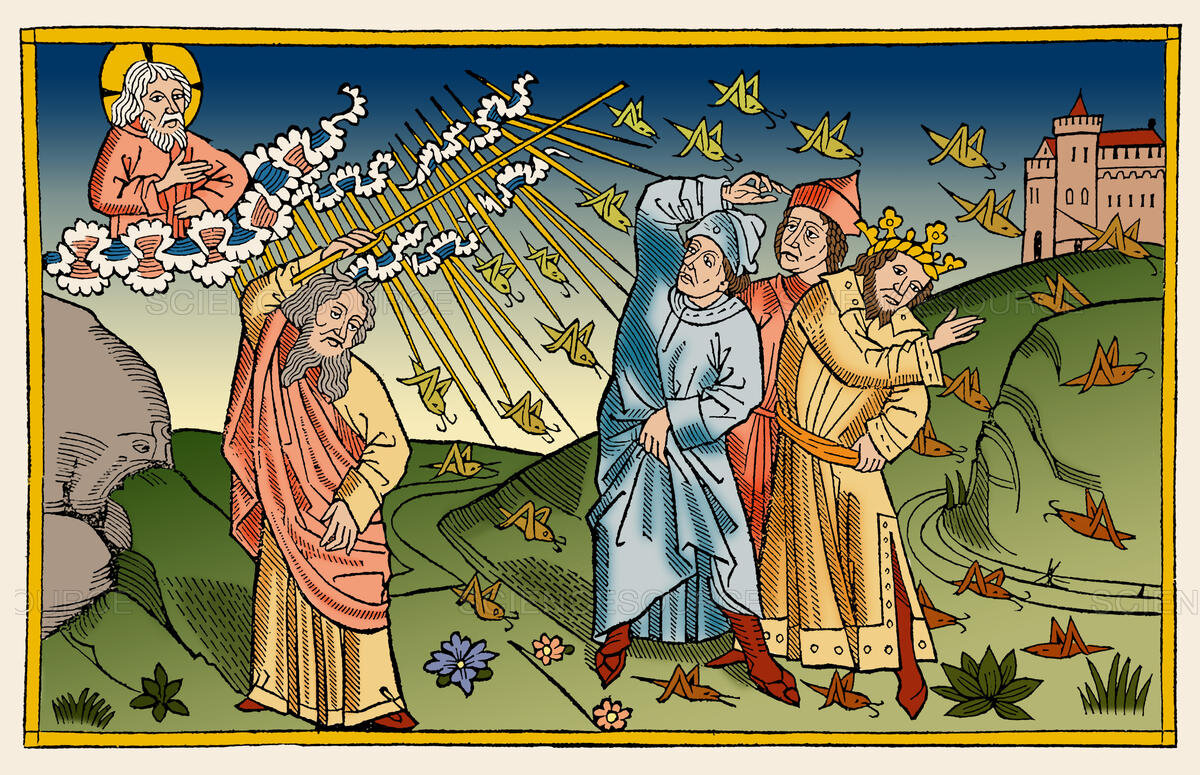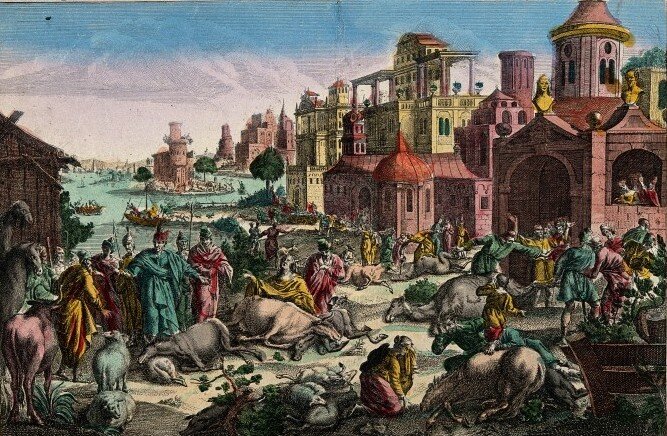A concise summary of the Old Testament book of Exodus, from the burning bush to the parting of the Red Sea.
Don’t upset a friend of Yahweh or you might end up with a dead son, as the pharaoh of Egypt did in the Old Testament tale of the Exodus. Death of the Firstborn by Lawrence Alma-Tadema, 1872
The poor Hebrews of the Old Testament. For years, they just couldn’t catch a break.
This ethnic group, which traces its roots to the 12 tribes formed by the sons and grandsons of Jacob, grew in power over 430 years. But the pharaoh of Egypt, fearing he would be betrayed to one of his many enemies, enslaved the Hebrews and forced them into construction gangs.
“To save their firstborns, Yahweh gave his Chosen People a secret code: Sacrifice a lamb and smear its blood on the doorposts.
That way Yahweh knew to spare that child by passing over the home — the origin of the Jewish festival of Passover (get it?). ”
Things got even worse after that. In a despicable form of population control, the pharaoh ordered that all male Hebrew children be drowned in the Nile. One child, though, from the tribe of Levi, was set adrift in a basket woven from bulrushes. It floated along until rescued by one of the pharaoh’s daughters. The child was given the name Moses, from the Hebrew root “to draw out,” and was raised in the royal court.
Pharaoh’s daughter rescued baby Moses in his basket adrift upon the Nile, as shown in another painting by Alma-Tadema, The Finding of Moses, from 1904.
When he grew into adulthood, Moses saw an Egyptian taskmaster flaying a Hebrew slave with a whip. Moses flew into a rage and killed the taskmaster, hiding the body in the sand. He still worried he’d be caught, though, and fled into the wilderness. This is where he heard the voice of the God of Israel, who revealed his mystical name, YHWH (throw in some vowels and you get Yahweh). The voice came from the depths of a burning bush that didn’t get consumed by the flames. It told Moses that he’d be the savior of his people and would lead them out of Egypt.
Moses and the Burning Bush, Edward Knippers, 2008
But did the event predicted by the talking bush, the Exodus, really happen? What does archeological and historical evidence reveal?
The plague of locusts devoured every last plant living in Egypt.
Out of Egypt: Escape of the Hebrew Slaves
Back to the beleaguered Hebrews. Pharaoh, taking out his wrath toward Moses, intensified the suffering of the slaves. Yahweh told Moses to give the pharaoh a warning that he’d better let the Hebrews go — or else. That “or else” turned out to be the 10 plagues, starting off with the Nile turning to blood, working through frogs, gnats, flies, a livestock disease, boils, hail, locusts and darkness, and ending with the slaughter of every firstborn in Egypt.
In one of the plagues, Yahweh caused the livestock of Egypt to contract a fatal disease.
To save their firstborns, Yahweh gave his Chosen People a gruesome secret code: Each Hebrew family sacrificed a lamb and smeared its blood on their doorposts. That way Yahweh knew to spare that child by passing over the home — the origin of the Jewish festival of Passover (get it?).
Yahweh swept through Egypt, laying waste to all the firstborns as depicted in this creepy painting And There Was a Cry in Egypt by Arthur Hacker from 1897.
Pharaoh didn’t learn his lesson. When the 600,000 or so slaves fled on foot into Canaan, the Egyptian ruler decided to pursue them. Yahweh parted the Red Sea, allowing the Hebrews to pass through, and then brought the waters crashing down upon the Egyptians.
The Red Sea parted for the Hebrew slaves seeking freedom in the Exodus — but came crashing back down to drown the pursing Egyptians.
Moses and the Ten Commandments by Barbara Goshu
The Ten Commandments: Thou Shalt Not Piss Off the Lord God
The Hebrews were hardly models of propriety. Moses was up on Mount Sinai getting the Ten Commandments written upon stone tablets from Yahweh, and by the time he returned, his people had started worshipping a golden calf.
Those fickle Hebrews. Moses wasn’t gone too long before they started worshipping a false idol, as seen in Nicolas Poussin’s The Adoration of the Golden Calf from 1634.
Moses was so upset he threw the stone tablets onto the ground, shattering them, and had to have God write up a new set.
Later, when spies reported that the cities of Canaan were well fortified and populous, the Hebrews had the gall to rebel against Moses, insisting they’d rather go back to being Egyptian slaves! At least their physical safety would be assured, they reasoned.
Well, this understandably pissed off Yahweh, who questioned his decision to name the Hebrews his Chosen People. They didn’t deserve no Promised Land; instead he decided to force them to wander the wilderness for 40 years to think about what they had done wrong. –Wally





























